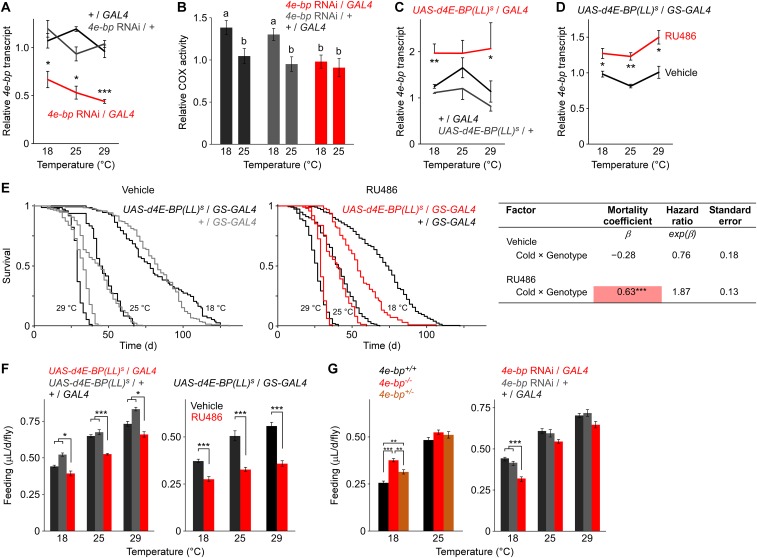Fig. S2.
Characterization of 4e-bp transgenic manipulations. (A and B) Relative 4e-bp transcript levels measured by qRT-PCR (A) and COX activity (B) in 4e-bp RNAi lines. RNAi lines harbored a UAS-controlled RNAi construct targeting 4e-bp and the ubiquitously expressed daughterless-GAL4 driver. Controls are hemizygous for each element. In B, labeled bars without a common letter differ, P < 0.05. *P < 0.05; ***P < 0.001. (C and D) Relative 4e-bp transcript levels measured by qRT-PCR in overexpression lines. Overexpression lines harbored a UAS-controlled activated form of 4e-bp [d4E-BP(LL)] driven by either the ubiquitously expressed constitutive armadillo-GAL4 driver (C) or the inducible daughterless-GS GAL4 driver (D). Controls for the constitutive driver are hemizygous for each element. For the GS driver, addition of RU486 to the diet results in overexpression of the UAS-controlled d4E-BP(LL) transgene. GS controls were given vehicle only. Results were normalized to RpL32 transcript levels. n = 2–6 vials of 20–30 flies for each genotype and temperature (A, C, and D). Comparisons between experimental and controls are shown for each temperature (Student’s t test: *P < 0.05; **P < 0.01). (E) Survival at three temperatures of the GS driver harboring the d4E-BP(LL) transgene or a control, fed vehicle (Left) or RU486 (Center). Cox proportional hazards analysis (Right) shows no significant interaction between temperature and genotype when animals were fed vehicle. Expression of activated 4E-BP with RU486, however, results in a significant interaction. The positive mortality coefficient suggests that inducing gene expression results in attenuated lifespan extension under cold. n = 48–198 flies per condition. ***P < 0.001. Wald χ2 = 252.5, P < 10−6 (vehicle); χ2 = 199, P < 10−6 (RU486). (F) Effect of 4e-bp overexpression on food intake. Feeding over 24 h was measured using radioisotope-labeling of the medium for d4E-BP(LL) overexpression driven by a constitutive GAL4 (Left) or inducible GS (Right), and their respective controls, as described in C and D. For the constitutive driver, n = 6 vials of ∼15 flies for each condition. For the GS driver, n = 10 vials of ∼10 flies for each condition. *P < 0.05; ***P < 0.001. (G) Effect of 4e-bp loss of function on food intake. Feeding over 24 h was measured using radioisotope-labeling of the medium for the 4e-bp–null mutant (4e-bp−/−) and its control (4e-bp+/+) (Left) or for 4e-bp RNAi and its controls (Right), as described in A. Feeding rate in a heterozygous mutant at 18 °C is intermediate of that of the null and control lines, demonstrating that moderate 4e-bp down-regulation does not explain the differences in total consumption between the null and RNAi manipulation. n = 10–15 vials of 20–25 flies for each condition. Only statistically significant differences between the experimental group (red) and controls are shown (**P < 0.01; ***P < 0.001, one-way ANOVA with Tukey–Kramer post hoc test for multiple comparisons or Student’s t test). All data are shown as averages ± SEM. Males were used in all studies.

